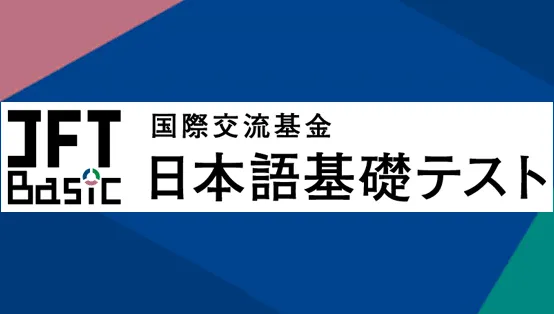What is the JFT-Basic Japanese language test, its differences from the JLPT, its levels, and practice questions

The JFT-Basic (Japan Foundation Test of Basic Japanese as a Foreign Language) is attracting attention as a new Japanese language test other than the Japanese Language Proficiency Test (JLPT). This article explains what the JFT-Basic is, including the types of questions and how to take the test.
Have you heard of the JFT-Basic test? As a new Japanese language test other than the Japanese Language Proficiency Test (JLPT), the JFT-Basic (Japan Foundation Test of Basic Japanese) has been attracting a lot of attention recently.
This article will introduce in detail what kind of test the JFT-Basic is for foreigners who are learning Japanese. We will explain in detail what kind of questions will be asked, how to apply, the differences from the JLPT, and specific practice questions. We hope you will find this information useful.
▼Goandup Picks Click here for recommended articles!
- Required before studying abroad! Goandup Nihongo+, an online Japanese language learning service
- This page introduces services for foreigners who wish to study in Japan or improve their Japanese language skills to learn Japanese online.
- Goandup Salon" community for foreigners living in Japan
- We introduce an online community where foreigners living in Japan can exchange information and interact with each other to support their life in Japan.
- Goandup Study" supports foreigners who want to study in Japan.
- This section introduces study abroad support services that provide comprehensive support to foreigners who wish to study in Japan, from preparation for study abroad to living in Japan.
- Where can I buy a prepaid SIM in Japan? Recommended SIM cards for foreigners are also introduced.
- How to purchase a prepaid SIM and suitable SIM cards for foreigners.
- The Complete Guide to Pocket Wi-Fi in Japan for Foreigners!
- We introduce how to select and recommend pocket Wi-Fi products that can be used conveniently in Japan.
- The Complete Guide to Finding a Job in Japan! Finding a job, changing jobs, and part-time work for foreigners
- This site provides foreigners who want to work in Japan with comprehensive information on how to find a job, recommended job sites, and other information necessary to find a job.
What is the JFT-Basic (Japan Foundation Test of Basic Japanese)?

The JFT-Basic (Japan Foundation Test of Basic Japanese) is a Japanese language test designed to determine whether foreigners who wish to work in Japan have the minimum Japanese language skills necessary for daily life in Japan. The test will be administered from 2019 and is currently being taken mainly in Asian countries. One feature of the test is that it can be used to prove the Japanese language proficiency required to obtain "Specified Technical Skills 1" status of residence.
Specified Technical Skills 1 is a status of residence for foreign nationals who are engaged in work requiring a certain level of expertise and skills, and covers 14 industries: construction, shipbuilding/marine industry, automobile maintenance, aviation, lodging, agriculture, fishing, food and beverage manufacturing, food service, nursing care, building cleaning, materials industry, industrial machinery manufacturing, and electrical, electronics and information related industries. The 14 industries covered are agriculture, fishing, food and beverage manufacturing, food service, nursing care, building cleaning, materials processing, industrial machinery manufacturing, and electrical and electronic information-related industries. To work in these industries, a certain level of Japanese language proficiency is required, so taking the JFT-Basic exam is recommended.
Difference between JFT-Basic and JLPT (Japanese Language Proficiency Test)
The JLPT (Japanese Language Proficiency Test) is the most major Japanese language test for learners of Japanese, but there are some differences between JFT-Basic and the JLPT. First, in terms of level setting, the JLPT is divided into five levels, from N1 to N5, while JFT-Basic is not divided into detailed levels, and is designed to measure Japanese language proficiency at approximately the level of N4 on the JLPT.
The frequency of the examinations also differs: while the JLPT is administered only twice a year (July and December), the JFT-Basic is administered six times a year, making it easier to take the exam. In addition, there is a difference in the speed of notification of test results: while the JLPT is given approximately two months after the test date, the JFT-Basic has the advantage that results are available within five business days of the test date.
In terms of test format, while the JLPT is a mark-sensing system focusing on reading and listening comprehension, the JFT-Basic emphasizes communication skills and is entirely computer-based with multiple-choice answers.
The main differences between the JLPT and JFT-Basic are
| JLPT | JFT-Basic | |
| Issue Characteristics | Emphasis on reading and writing skills | Emphasis on communication skills |
| level | 5 levels from N5 to N1 | JLPT N4 level equivalent |
| Number of times implemented | Twice a year | 6 times a year |
| Notification of test results | After 2 months | Within 5 business days after the completion of the test |
| Test format | mark sheet | multiple choice (e.g. question) |
Thus, the JLPT and JFT-Basic have different characteristics in terms of level setting, purpose of the test, and form of administration. It is important to choose the appropriate test according to your own objectives and learning situation.
For your information, please also refer to the following articles related to the Japanese Language Proficiency Test (JLPT).
・What is the pass rate for JLPT N1?
・What is the level difference between JLPT N1, N2, and N3?
Outline of the JFT-Basic (Japan Foundation Test of Basic Japanese as a Foreign Language)

To learn more about JFT-Basic, here is a detailed overview of the exam, including the question format, examination method, and difficulty level.
JFT-Basic" Test Contents
The JFT-Basic exam consists of approximately 50 questions in total, which must be answered within a limited time of 60 minutes. The exam is administered entirely on the computer, and the examinee answers the questions while listening to the question text, answer choices, and audio displayed on the screen.
The format of the test is divided into four sections: "Letters/Vocabulary," "Conversation/Expressions," "Listening Comprehension," and "Reading Comprehension," each with around 12 questions (see below for more details). The test is based on a multiple-choice format, and there is no writing or speaking component. Many of the questions are practical questions based on real-life situations in Japan.
JFT-Basic Application Procedures and Examination Fees
To take the JFT-Basic exam, you must apply for it through a dedicated website. Select the country (Japan, Myanmar, Nepal, etc.), venue, date and time, and enter the required information.
The examination fee varies from country to country, but the standard fee is 10,000 yen for those taking the exam in Japan. In Thailand, for example, the fee is 1,260 baht (approximately 5,300 yen), and in the Philippines it is 2,010 pesos (approximately 5,400 yen), so in most cases the fee is between 5,000 and 6,000 yen.
However, details such as how to pay the examination fee may vary from country to country and venue to venue, so we recommend that you check in advance.
Reference:Exam Fees by Country|Prometric
Levels of difficulty for JFT-Basic
As mentioned at the beginning of this article, the difficulty level of the JFT-Basic test is said to be equivalent to JLPT N4. N4 is defined as "the level of being able to understand basic Japanese," and requires the ability to understand and use Japanese used in everyday situations to some extent.
However, it is not necessary to have a perfect understanding of the specialized knowledge and nuances of the Japanese language, and it is possible to pass the test if you can interact with the language in situations that are directly related to your daily life. In fact, the minimum passing score for JFT-Basic is 200 out of 250 points, and the passing rate is approximately 401 TP49T, which is not very high.
However, this is only an average figure, and the success rate varies greatly depending on the examinee's history of Japanese language study, native language, study environment, and other factors. It is essential to be diligent in your preparation and to acquire basic skills.
Reference:JFT-Basic Japan Foundation Test of Basic Japanese
Four areas of questions and exercises in JFT-Basic

As mentioned earlier, JFT-Basic is divided into four sections: "Letters/Vocabulary," "Conversation/Expressions," "Listening Comprehension," and "Reading Comprehension. Here we will look at the characteristics of each section and specific practice questions.
Please note that in the actual test, the questions in each section are presented in the examinee's native language, such as English, Chinese, or Indonesian. The examples below are presented in Japanese, but except for the listening questions, there will basically be no questions in Japanese.
Script and Vocabulary
In the "Character and Vocabulary" section, there will be questions on the meanings and usages of Japanese words and how to read kanji. Frequently appearing vocabulary words and expressions, which are commonly seen in daily life, tend to be selected.
exercises
Choose the best way to read the following Kanji characters from the choices below.
- "Suito."
- "Waterway."
- "Sino-do."
*The correct answer is #2, "suido".
Conversation and Expression
The Conversation and Expression section tests your ability to use appropriate grammar and expressions in everyday conversation. This section tests practical communication skills such as colloquial expressions, polite language, and the use of conversation with friends and superiors.
exercises
Choose one of the following options for the most appropriate expression to fill in the blanks of the following conversational text.
(The actual conversation is a bit longer)
I'm going out to eat, would you like to join me?"
Excuse me, I'm having a potty break today. ____ please."
- "My pleasure."
- Again.
- Another time.
The correct answer is #1, "See you next time.
Listening Comprehension
In the "Listening Comprehension" part, you will be tested on your ability to listen to Japanese conversations and utterances and correctly understand their content. All conversations are in Japanese, so you need to concentrate on listening to them. The questions and choices are written in the examinee's native language, and the format is to select the one that matches the content of the audio.
exercises
Listen to the following conversation and answer what the man did with his friends during New Year's.
(Part of a conversation. Actual conversation is longer)
Man: "On New Year's Day, my friends came to visit me. But my friend caught a cold, so I stayed at home. I really wanted to show him around town or visit a shrine.
Woman: "I see. That's a shame."
- Illustration of walking around town with friends."
- Illustration of walking through a shrine with friends."
- Illustration of being at home with friends.
*The correct answer is #3, "Illustration of being at home with friends.
Reading Comprehension
The "Reading Comprehension" section tests the ability to read and understand the content of everyday texts such as e-mails, letters, and explanations. In addition to kanji reading and vocabulary, many questions will test your overall Japanese language ability to understand and appropriately interpret the context.
exercises
Read the following public information magazine and answer the questions below.
| International Stival was held on February 24th (Sun.) at Bunka Hall In the morning, the world song and dance stage and the world okki concert were held. At the concert, there was a corner where visitors could explore Okki. Food and accessories from various countries were sold in the square outside. In the afternoon speech contest, Japanese people spoke in a foreign language and foreigners spoke in Japanese. Mr. Hoa from Vietnam, who won the prize, said, "It was my first time to give a speech, but I was able to speak well. I talked about interesting experiences in Japan. It was great that everyone could understand me so well. I was also surprised to see a Japanese person giving a speech in my language. I was surprised to see a Japanese person giving a speech in my country's language," he said. |
Question 1. what did those who went to the Festival do?
- "To see singing and dancing."
- "To buy a musical instrument."
- "Making jewelry."
Question 2: How did Mr. Hoa feel about participating in the speech contest?
- I didn't have a speech contract, but it went well.
- I was so sad to hear that my speech was being criticized.
- I was surprised at how good the Japanese speakers were in English.
*The correct answer is #3 for question 1 and #1 for question 2.
These are the four sections of JFT-Basic and the exercises. How was it?
In the actual test, the questions are often longer conversations or reading comprehension passages. In listening comprehension, the choices are sometimes presented as illustrations of the content of the conversation, so the ability to make quick judgments based on visual information as well as audio is required.
The key to success in the examinations is to be exposed to a large number of practice exams and past examinations to get a grasp of the trends of the questions.
Source:Question 1|JFT-Basic The Japan Foundation Japanese-Language Proficiency Test
How do I get accepted for JFT-Basic?

The JFT-Basic test focuses on the ability to communicate at a daily conversational level, rather than on detailed nuances and advanced expressions in Japanese. Therefore, in order to prepare for the test, it is important to first acquire basic vocabulary and grammar, and then accumulate practice in applying them to real-life situations.
Improve vocabulary and grammar skills
For beginners of Japanese language study, it may be a hurdle to suddenly start conversation practice. Start by reading and writing hiragana, katakana, and simple kanji commonly used in daily conversation. Then, repeat the practice of reading short sentences aloud and answering simple questions.
To increase vocabulary, it is effective to look at not only textbooks, but also newspapers, magazines, menus, signboards, and other written Japanese information found in everyday life. By getting into the habit of looking up unfamiliar words in a dictionary each time you come across them, you will gradually improve your vocabulary.
Improve vocabulary and grammar skills
When learning grammar, it is important to grasp basic rules such as the use of particles and verb conjugations, but it is essential not only to memorize them, but also to practice using them. It is also recommended that you consciously try to create opportunities for output, such as talking to people around you in Japanese or using Japanese on social networking sites.
In addition, a shortcut to improving your listening skills is to be exposed to a large number of Japanese speech sounds. One way is to imitate the tone of voice and intonation while watching and listening to dramas, anime, news programs, etc. If you find a word you don't understand, don't forget to actively look it up.
Reading a large number of Japanese texts is essential for strengthening reading comprehension. Let's start with picture books in easy Japanese and gradually try a variety of genres, such as narrative and explanatory texts. The important thing is to summarize what you read in your own words. This is also a good way to practice grasping the general flow of the text.
Use of Learning Resources
JFT-Basic's official websiteintroduces you to useful teaching materials, practice questions, and online learning tools that will help you prepare for the exam. If you are not comfortable proceeding on your own, you may also want to attend a Japanese language school or take online lessons. In particular, we recommend Goandup Nihongo+, an online Japanese learning service. For more information about the service, check out the following article
▶︎ No Need to Study Abroad Anymore? Goandup Nihongo+, an Online Japanese Learning Service
Finding a learning style that suits you is of utmost importance.
Serious employment support to help you realize your dream of working in Japan!

Do you want to work in Japan?
Let us "Goandup" make that dream a reality!
【 Program Features 】
✅ JLPT N3 level Japanese language acquisition
✅ Thorough preparation for the specific skills test
✅ Full support for job hunting in Japan
Business-focused one-on-one lessons will help you find a job in Japan in the shortest possible time.
【 Program Menu 】
- Individual Japanese language lessons
- Intensive curriculum to obtain N3, especially specialized lessons for business Japanese that can be used at work.
- Intensive curriculum to obtain N3, especially specialized lessons for business Japanese that can be used at work.
- Preparation for the Specific Skills Test
- Customized materials for specific skill tests will be used to focus on frequently asked questions and learning to pass the test.
- Customized materials for specific skill tests will be used to focus on frequently asked questions and learning to pass the test.
- Resume and CV support
- To create resumes and CVs tailored to Japanese corporate culture, and to brush up on self-promotion and motivation for application.
- To create resumes and CVs tailored to Japanese corporate culture, and to brush up on self-promotion and motivation for application.
- Interview Preparation
- Guidance on areas for improvement through mock interviews and feedback based on corporate interview scenarios. Learn interview etiquette and behavior unique to Japan.
- Guidance on areas for improvement through mock interviews and feedback based on corporate interview scenarios. Learn interview etiquette and behavior unique to Japan.
- career consulting
- Provide introductions to companies that match the participant's career goals, select companies to apply to, and provide advice on the level of knowledge required by the companies to which the participant is applying.
- Provide introductions to companies that match the participant's career goals, select companies to apply to, and provide advice on the level of knowledge required by the companies to which the participant is applying.
- Chat Support
- In addition to one-on-one individual lessons, we also accept casual questions via DM (visa application, living support, assistance in finding a room, etc.).
If you are serious about your career in Japan, join us now!
▶︎ for more informationclick here.
We will do our best to support your success in Japan!
summary
In this issue, we have explained in detail the JFT-Basic, which is attracting increasing attention among learners of Japanese, including an overview of the exam, its features, and key points in preparing for the exam.
The JFT-Basic may still be less well-known than the JLPT, but its practical content, which tests "Japanese language skills as a consumer," has been increasingly gaining presence in recent years. In particular, it is an unavoidable test for those who aim to acquire the "Specific Proficiency 1" qualification.
On the other hand, there are some differences from the JLPT, such as the lack of segmented level settings like the JLPT and the tendency of questions to emphasize communication rather than reading comprehension. It is important to carefully consider which exam is more appropriate for you, taking into account your objectives and learning situation.
Please use the practice questions presented in this article as hints for your daily study. With continuous effort, your Japanese language skills will surely improve, and you will be able to make steady progress toward passing the JFT-Basic exam.
Also, please refer to the following articles on Japanese language study.
・What is the Japanese language test that foreigners who want to work in Japan should take?
・A must-see for foreigners who want to work in Japan! Explanation about "NAT-TEST" which can visualize your Japanese language skills!
Your support will help us!
Thank you for visiting Goandup Picks. Our mission is to provide you with more useful information to show the world what Japan has to offer.
Your support will help us to further enhance our activities, so please support us!





